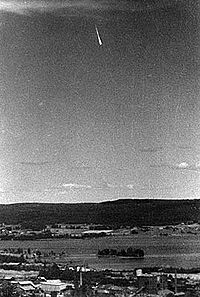This article has multiple issues. Please help improve it or discuss these issues on the talk page. (Learn how and when to remove these messages)
|

Ghost rockets (Swedish: Spökraketer, also called Scandinavian ghost rockets) were rocket- or missile-shaped unidentified flying objects sighted in 1946, mostly in Sweden and nearby countries like Finland.
The first reports of ghost rockets were made on February 26, 1946, by Finnish observers.[1] About 2,000 sightings were logged between May and December 1946, with peaks on 9 and 11 August 1946. Two hundred sightings were verified with radar returns, and authorities recovered physical fragments which were attributed to ghost rockets.
Investigations concluded that many ghost rocket sightings were probably caused by meteors. For example, the peaks of the sightings, on 9 and 11 August 1946, also fall within the peak of the annual Perseid meteor shower. However, most ghost rocket sightings did not occur during meteor shower activity, and furthermore displayed characteristics inconsistent with meteors, such as reported maneuverability.
Debate continues as to the origins of the unidentified ghost rockets. In 1946, however, it was thought likely that they originated from the former German rocket facility at Peenemünde, and were long-range tests by the Soviets of captured German V-1 or V-2 missiles, or perhaps another early form of cruise missile because of the ways they were sometimes seen to maneuver. This prompted the Swedish Army to issue a directive stating that newspapers were not to report the exact location of ghost rocket sightings, or any information regarding the direction or speed of the object. This information, they reasoned, was vital for evaluation purposes to the nation or nations assumed to be performing the tests.
- ^ Kevin D. Randle; Russ Estes (21 August 2000). Spaceships of the visitors: an illustrated guide to alien spacecraft. Simon and Schuster. p. 47. ISBN 978-0-684-85739-8.